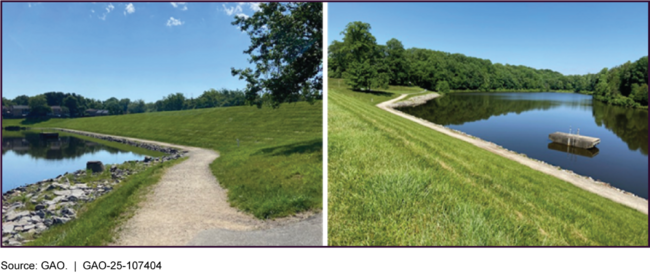Watershed Dams: Better Program Management Would Improve Safety
Fast Facts
The U.S. Department of Agriculture helped build almost 12,000 watershed dams throughout the U.S. These dams control flooding and prevent damage to communities. However, age-related deterioration and other factors have raised concerns about their safety.
USDA monitors how project sponsors (typically local governments) operate and maintain the dams. It also funds dam rehabilitation. We found USDA’s approach has been inconsistent and key information on dams—such as their condition—is missing or inaccurate. Also, USDA has not transparently communicated or documented its funding process.
We recommended actions to improve how USDA manages dam safety.
A Natural Resources Conservation Service Watershed Dam in Texas

A body of water, grass, and trees in the background
Highlights
What GAO Found
The U.S. Department of Agriculture's (USDA) Natural Resources Conservation Service (NRCS) has a variety of dam safety responsibilities but has not consistently implemented them. NRCS assists project sponsors—typically local governments—in designing, planning, constructing, and rehabilitating watershed dams. Sponsors are responsible for safely operating and maintaining dams according to federal, state, local, and tribal laws and regulations. NRCS's responsibilities include (1) monitoring sponsors' compliance with operation and maintenance requirements, and (2) maintaining a national data inventory of NRCS-assisted dams. However, NRCS has not consistently reviewed operation and maintenance agreements with sponsors every 5 years or monitored the timely completion of dam inspections. As a result, 32 percent of significant- and high-hazard dams within their evaluated lives were past their required inspection due date, as of August 2024. In addition, key safety information NRCS collects—such as the condition of some dams—is missing or inaccurate. Without complete and accurate data, NRCS cannot ensure the safe operation and maintenance of dams across the country that help protect communities from flooding.
A Natural Resources Conservation Service Watershed Dam in Virginia

In addition, GAO found that some of NRCS's processes for funding rehabilitation projects are not fully transparent. NRCS's Watershed Rehabilitation Program (REHAB) provides project sponsors with funding to rehabilitate their dams, to help meet safety and performance standards. However, NRCS has not fully communicated to project sponsors key information related to funding availability, eligibility, or the types of projects to be funded. Sponsors for eight of the 25 dams GAO met with said they were either unaware of REHAB or unclear about the requirements for receiving funding. Without improved communication about the program, project sponsors may continue to miss opportunities to address critical safety issues. Additionally, for fiscal year 2024, NRCS did not document why its state offices advanced some applications to headquarters for funding consideration and not others. NRCS officials said the specific rationale for prioritizing some projects over others can vary by state. Without guidance for NRCS state offices to document the rationale for these decisions, NRCS cannot ensure it allocates funds in a consistent and transparent manner that aligns with agency goals to protect lives, property, and infrastructure.
Why GAO Did This Study
NRCS assisted in the designing, planning, and construction of nearly 12,000 watershed dams to control flooding and prevent damage to communities. Most of these dams were built between 1954 and 1980 in rural, agricultural areas of the U.S. As these dams have aged and surrounding areas have developed, stakeholders are concerned about the safety of the dams.
GAO was asked to review how NRCS manages dam safety. This report assesses the extent to which (1) NRCS has implemented its dam safety responsibilities, and (2) NRCS's processes for funding dam projects under REHAB are transparent.
GAO reviewed NRCS policies, guidance, and data, as well as relevant federal laws and regulations. GAO selected a nongeneralizable sample of 25 dams in five states based on condition, geography, and other factors. For these dams, GAO reviewed documentation and interviewed project sponsors. GAO conducted site visits at 10 of these dams in three states and interviewed officials from NRCS, state dam safety offices, and other stakeholders.
Recommendations
GAO recommends that NRCS take steps to (1) monitor project sponsors' compliance with operations and maintenance requirements; (2) collect and verify key dam data; (3) communicate key information to project sponsors about REHAB funding opportunities; and (4) document the rationale for its decisions to advance REHAB applications for funding. USDA agreed with GAO's recommendations.
Recommendations for Executive Action
| Agency Affected | Recommendation | Status |
|---|---|---|
| Natural Resources Conservation Service | The Administrator of NRCS should develop mechanisms to consistently implement NRCS's policies and procedures for monitoring project sponsors' compliance with operation and maintenance requirements for watershed dams. These mechanisms should provide direction for (1) reviewing operation and maintenance agreements made between NRCS and sponsors; (2) monitoring formal dam inspections; and (3) investigating sponsors' potential violations of operation and maintenance requirements. (Recommendation 1) |
When we confirm what actions the agency has taken in response to this recommendation, we will provide updated information.
|
| Natural Resources Conservation Service | The Administrator of NRCS should develop a quality assurance plan and guidance for state and district offices for collecting and verifying key information in NRCS's dams database. (Recommendation 2) |
When we confirm what actions the agency has taken in response to this recommendation, we will provide updated information.
|
| Natural Resources Conservation Service | The Administrator of NRCS should develop a mechanism to communicate key information about REHAB funding opportunities to project sponsors, including information related to available funding (such as cost share requirements), eligibility, and types of projects to be funded. (Recommendation 3) |
When we confirm what actions the agency has taken in response to this recommendation, we will provide updated information.
|
| Natural Resources Conservation Service | The Administrator of NRCS should develop guidance for NRCS state offices to document the rationale for their decisions to advance applications to NRCS headquarters for funding. (Recommendation 4) |
When we confirm what actions the agency has taken in response to this recommendation, we will provide updated information.
|
